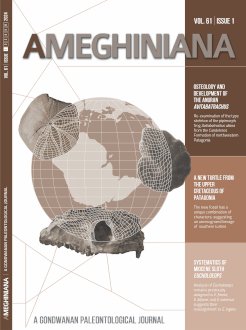One of the most endemic Lower Devonian fauna in the Central Andean Basin of Western Gondwana is the association of brachiopods characterized by the terebratulid Scaphiocoelia boliviensis. This benthic association is analyzed in seven localities in the strike and the dip of the basin (Ayo Ayo, Belén, Candelaria-Icla, El Peral-Presto, Sobo Sobo, Sella, and Abra de Zenta) integrating several ages based on palynomorphs, mainly chitinozoans, that have been published in the last 20 years. The Scaphiocoelia biofacies is defined from the statistical treatment of 31 associated taxa in seven columns of Pragian age. In addition, the most frequent facies enclosing the biofacies are discussed. The result of this integration postulates habitat tracking as a migration strategy for the biofacies, following the basic pattern of Walther's law. Likewise, the Scaphiocoelia biofacies responds to the sea level fluctuations in a regressive-transgressive cycle, with an important development in the maximum regression surface, the falling stage-lowstand systems tracts and in some fine-grained sandstones of progradations in the highstand systems tract. At the beginning of the transgression, the Scaphiocoelia biofacies keep its composition in fine sandstone beds but disappear before the maximum flooding and poorly oxygenated levels. The diachronic character of this biofacies is stressed when correlations in the basin and between basins are made.
Una de las asociaciones de fauna más endémica del Devónico Inferior de la Cuenca de los Andes Centrales del Gondwana Occidental, es la asociación de braquiópodos característicos por la presencia del terebratúlido Scaphiocoelia boliviensis. Esta asociación bentónica es analizada en siete localidades en el rumbo y en la pendiente de la cuenca (Ayo Ayo, Belén, Candelaria-Icla, El Peral-Presto, Sobo Sobo, Sella y Abra de Zenta), integrando numerosas dataciones en base a palinomorfos, fundamentalmente quitinozoarios, que se fueron publicando en los últimos 20 años. Se define la diagnosis de la biofacies de Scaphiocoelia, a partir del tratamiento estadístico de 31 taxones asociados en siete columnas del Pragiano. Además, se dan a conocer las facies más frecuentes donde aparece la biofacies. El resultado de esta integración de datos postula para la biofacies un hábitat de “caminamiento” como estrategia de migración, cumpliendo con un patrón básico de la ley de Walther. Así mismo, la biofacies responde a las fluctuaciones del nivel del mar en un ciclo regresivo-transgresivo, con un importante desarrollo en las superficies de máxima regresión, los cortejos sedimentarios de caída del nivel del mar y de nivel del mar bajo y en algunos niveles arenosos finos de progradaciones en el cortejo sedimentario de nivel del mar alto. Cuando se inicia el ciclo transgresivo, la biofacies de Scaphiocoelia se instala en los niveles arenosos finos y desaparece cuando este alcanza el máximo nivel de inundación y empobrecimiento de oxígeno. Se advierte de la necesidad de tener en cuenta el carácter diacrónico de esta biofacies al momento de hacer correlaciones en la cuenca y entre cuencas.





